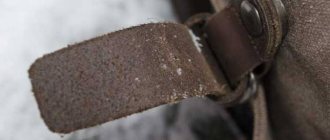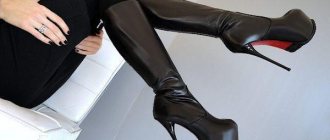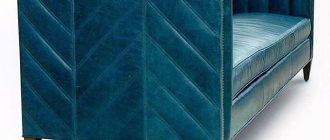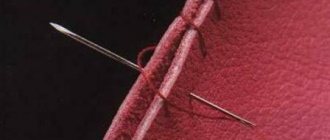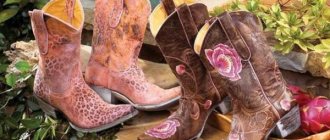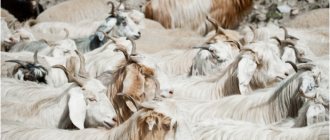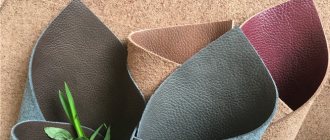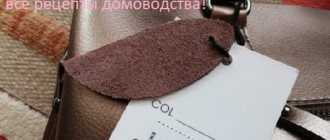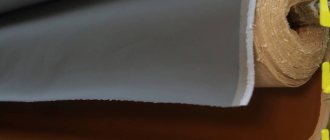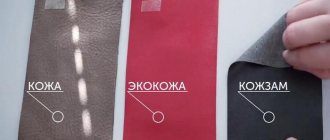Home / Leather and its substitutes
Back
Published: 12/11/2020
Reading time: 3 min
1
811
Pressed leather is not much different in appearance from natural raw materials. Its low price attracts buyers. The products look aesthetically pleasing, there are no creases or cracks. Manufacturers claim that with proper care, items made from recycled materials will last for several years. What it is, what its main characteristics, properties and features will be discussed in today’s article.
- 1 General characteristics
- 2 Raw materials and manufacturing
- 3 Differences between pressed and real leather
- 4 Positive and negative properties
- 5 Application
- 6 Recommendations for choosing products
- 7 Features of care
- 8 Conclusion
Description and production
what does pressed leather look like?
What artificial leather is made from: pieces, dust, trimmings - any remnants of natural material.
Interesting
In addition to primary raw materials, secondary ones are used. That is, the remains of the skin from the press are also used.
How to make pressed leather:
- The remains of natural materials are crushed using a special device.
- The composition is removed from excess impurities and debris. Remove all components not related to the skin.
- They are connected to each other under strong pressure from a leather press. To make the connection happen, polyester, polyamide, and polyethylene fibers are added.
- The resulting piece of flat material is dried in a special oven.
- At high temperatures, synthetics melt and bind together natural tanning waste. In addition to fibers, polyester resins are added. They promote reliable adhesion of skin particles. Synthetic substances impregnate the fabric for better adhesion.
- It is cooled and the resulting leather is pressed, ready for finishing.
- The fabric is dyed and designs are applied. They change the texture, structure, relief. Add embossing.
Synthetic leather cannot withstand cold or extreme heat. In the summer, under the sun, at high temperatures, it will begin to melt and lose its shape. In winter, such products crack and become covered with wrinkles. The thing will burst at the bend in two or three months. The canvas does not hold its original shape for long. It does not allow air or moisture to pass through; a person will quickly sweat in such clothes and shoes.
The material also has advantages:
- inexpensive;
- externally similar to natural, indistinguishable at first glance;
- Suitable for making many items;
- beautiful designer things are created from it.
When choosing the right product, recycled matter will bring only positive emotions.
This is interesting: Ecofiber - what kind of filler is it: pros and cons, differences
Properties
Composite leather looks very similar to natural leather. It seems to be made from natural raw materials, but not from fully processed animal skins. Although the material is easily polished, varnished, and painted, it does not reach its natural counterpart in a number of properties:
- low air permeability due to the resins used, as well as gluing and pressing procedures;
- insufficient strength, especially at temperatures below ─ 15°C;
- wetness;
- inelasticity;
- impracticality;
- fragility.
But inexpensive products made from pressed material sell well.
Advantages
Pressed leather is used to make shoes and outerwear. Various accessories are popular: bags, backpacks, purses, purses, wallets, business card holders, belts, covers for documents and diaries. Can be used to cover furniture. It is combined with other materials . A number of designers willingly use pressed leather and display it in their collections.
- Externally it does not differ from genuine leather.
- Looks aesthetically pleasing.
- Does not require complex care.
- Low moisture permeability.
- Pores of equal depth and shape.
- Smooth sealed edges.
- Used to make clothing, shoes and accessories.
- Affordable price.
Products made from high-quality material look presentable, but will only last a couple of seasons. A special problem is places of constant load (bends, holes in belts), which quickly become deformed and break .
Application
Press leather is actively used in various fields. Outerwear is made from it. These are mainly light leather jackets. The material used is not thick, maximum 2 mm.
Bag ateliers often use non-natural materials to sew their products. This is especially true for mass market products that copy well-known brands.
For shoes, press leather is used as additional elements. Winter models are not sewn. Such shoes will not keep you warm in cold weather. Your feet will not only get cold, but also sweat.
Car covers are sewn from thick pressing and used as furniture upholstery.
Fashionistas take note! The real boom of the fall-winter 2021 season is leather pants and leggings. Most of them are made of pressed leather. Such models look sexy and impressive.
Comparison of recycled leather with other materials
A major supplier of such products is China. Manufacturers do not always indicate which material is used. Instead of “bonded leather”, “reconstituted leather” (i.e. “restored leather”) they simply write “leather”. However, if a leather wallet costs only 1000 rubles, this should alert the buyer. How to distinguish real leather from its imitation?
Differences from genuine leather
Natural leather is made from animal skins. It is suitable for the manufacture of various products only after numerous technological procedures. Using a series of sequential dressing operations, it is possible to obtain a strong, hygienic and durable material while maintaining the natural structure. It can withstand frost, numerous bends, getting wet, drying, etc.
Unlike natural leather, recycled leather cracks at low temperatures because the ester resins do not tolerate cold. It quickly loses its appearance and has low hygienic and environmental qualities. Feet in shoes made from it sweat and “burn,” and the shoes and boots themselves do not last long. To distinguish natural leather from recycled leather, you need to pay attention to the following parameters:
- Smell. The pressed material is very similar to natural. However, if you bring the item close to your nose, you can detect chemical notes.
- Thermal conductivity. Real leather will heat up and remain warm for a short time, the temperature of recycled leather will not change.
- Elasticity. If you press with your finger or bend a natural product, the skin will quickly recover, leaving no folds or creases. The marks will remain on the analogue for a long time.
The structure and color of natural leather is not uniform. The pores are similar, but do not look the same. The recycled substitute is painted evenly and looks perfect. Sealed seams and flat, straight edges are characteristic of recycled leather products. The edges of real leather items are deeply folded and rolled.
When moisture gets in, natural material quickly absorbs it and darkens. The analogue does not have such a property. He will remain the same as before. If the skin is set on fire, it smolders. The restored canvas becomes ash.
Leather products always come with a piece of the material from which they are made. If it is cut in the shape of a diamond, this is an indication of pressed material or leatherette. The label in the form of stretched skin means the raw material is natural (see photo).
Which is better – recycled leather or eco-leather?
Eco-leather is an artificial fabric that imitates natural leather and differs little from it in performance properties. It withstands changes in temperature and humidity, is durable and practical, elastic, resistant to wear and tear and, unlike natural leather, does not smell.
Eco-material “breathes”, heats up when touched, and is resistant to minor deformations. The tactile sensations when contacting it are more pleasant than when contacting recycled fabric. In addition, it is hypoallergenic, and this distinguishes it from its natural counterpart and pressed fabrics. Often eco-leather acts as a companion to natural leather.
What is better – pressed leather or eco-leather? When answering this question, factors such as quality, type of item (accessories, clothing or shoes), budget and planned operating time are taken into account.
Sensitive people and allergy sufferers should choose hypoallergenic eco-leather. Outerwear and shoes should also be purchased from this material; it is better to use it to cover car seats.
Good passport covers and diaries are made from recovered material. You can take a closer look at handbags and belts. Typically, leather goods last no more than 1–2 seasons. High-quality samples, if properly cared for, are more durable.
Recommendations for choosing products
Faux leather comes in high and low quality. When choosing things from this material, you need to pay attention to small details.
There should be no strong chemical smell. Otherwise, production technologies were violated. Creases and cracks are a bad sign. It only means that the material is too thick (more than 5 mm).
Pay special attention to the edges of the item. They must be processed. If this is not done, the product will quickly become frayed.
If the product has stains, it is better to choose something else. Getting rid of them is a big problem.
Flaws
Like any material, pressed leather has a number of features that can cause certain problems during use:
- It smells like genuine leather with synthetic impurities.
- Low breathability.
- Permits moisture.
- Does not withstand low temperatures (cracks).
- At high temperatures it loses its shape.
- Wears out quickly.
- Low elasticity.
- Low hygienic characteristics (feet in such shoes sweat easily).
- Doesn't retain heat.
- Deformed.
- May cause allergic reactions.
- Not eco-friendly.
How do retinoids work?
The mechanisms of retinoids that lighten age spots and even out skin tone:
- Inhibit tyrosinase
- Inhibit the process of pigment transfer into melanocyte pigment cells
- Normalize cellular renewal and stimulate timely exfoliation of pigmented horny scales from the surface of the skin.
- They stimulate keratogenesis - the appearance on the surface of the skin of cells with a normal, genetically programmed amount of pigment, i.e. normally colored.
- They work as conductors for other active ingredients, ensuring their deep penetration.
Retinoids are a group of substances derived from vitamin A. Due to their physiological effects on the skin, they effectively rejuvenate, eliminate acne and lighten the skin. Knowing the principles of operation and rules of application, Retinoids can achieve true correction of many skin problems.
Differences from natural
- Smell. The pressed product does not have a specific aroma, which any natural leather, including boiled leather, has.
- Temperature of the material. If you squeeze the compact in your hands, it will not warm up. Natural skin will become warm and will maintain its temperature for several minutes.
- The wrong side. Pressed leather has a smooth back side, while natural leather looks like suede.
- Water resistance. Natural material absorbs water, from which it becomes covered with dark spots. It does not pass through stamped leather.
- Appearance of the cut. Stamped leather has threads or fabric visible on it.
- Seam quality. They are sealed in press leather and have a flat, straight edge. The natural product has large seams, folded on both sides.
- Reaction to fire. When set on fire, genuine leather smolders, emitting a specific odor, while pressed leather completely burns and turns to ash.
- Label icon. The diamond represents pressed leather, and the stretched leather represents a natural product.
This is interesting: What is felt: types of material, qualities, care features
How to check leather for naturalness by appearance
Often, unscrupulous manufacturers try to pass off a pressed product as natural, increasing its cost. It is extremely difficult to distinguish between these materials, especially if you don’t know what to look for.
Quality of stitching and internal seams
To determine the type of material, you must first pay attention to the quality of the stitching and internal seams. If they have signs of adhesion, then the product is pressed. In addition, when processing natural fabric, in most cases a hem is made. The seams in this case are thicker. When processing artificial fabric, they become thinner.
Material thickness and edge
Thickness is not always indicative when determining the type of product. This parameter depends on the quality of the finish. In this case, inspection of the edge reveals the structure. In natural products it is represented by a large number of suede fibers. On a cut of artificial fabric you can see the threads.
Elasticity and color when pressed or bent
Another parameter that you need to pay attention to is color and elasticity when bending and pressing. If the material is natural, such manipulations do not change color. It is characterized by increased elasticity. The structure of the canvas does not change. Natural material that has been bent quickly regains its shape. Pressed leather has low elasticity, so defects remain on it for a long time.
Relief and pores of the material
Cured leather always has an uneven texture. The pores are directed in one direction. They are similar, but they cannot be identical. Synthetic leather has a repeating texture.
Back: fiber or fabric
To determine the quality of the material, it is advisable to examine the reverse side. Products made by pressing, in most cases, have a fabric base. The reverse side of the natural material resembles loose suede. At the same time, some unscrupulous manufacturers glue artificial suede to the reverse side. In this case, only examination of the section allows us to determine the type of product.
Why retinoids will help?
Retinoids perform 3 important functions in lightening pigmentation:
- Lightening – reduces melanin production
- Antioxidant protection – reduces the amount of free radicals that provoke melanin hyperproduction. They have a calming effect on excited pigment cells.
- Exfoliation – accelerates cellular turnover and removes stained skin cells
Retinoids cope with all three tasks simultaneously, which reduces the number of products used to one.
Other types
Different types of leather are necessary, because natural primary raw materials are not enough for everything. Not all products require such an expensive fabric.
Vinyl leather
This is a fabric with a porous or uniform one-sided PVC coating. How it is made:
- Preparation of the fabric base. The type of fabric will be determined by subsequent properties.
- Treatment of the base with solutions and polymer melts.
- The final finishing with the application of a pattern adds texture.
What is good about vinyl leather:
- resistance to abrasion, scratches, mechanical stress;
- tensile strength;
- resistance to ultraviolet radiation, moisture;
- tolerates temperature changes;
- does not deteriorate in chlorinated and sea water;
- tolerates treatment with disinfectants, ingress of oils and gasoline.
What is it used for:
- shoes, haberdashery;
- production of furniture of different price segments;
- metal door trim;
- finishing of residential, office and utility premises.
Vinyl leather is the material of the future. At a relatively low cost, it has good characteristics.
Boiled
Rigid, durable material, yet lightweight. Boiled leather is made by vegetable tanning. After this, they are sent into an adhesive solution or hot water. Oil, wax, rosin, and resins are also used.
Then fattening and painting occurs. At the end it is formed, embossed and dried. Previously, this type of leather was used for cases, sheaths, and sheaths. In antiquity and the Middle Ages for shields and armor.
Stamped
Modern saffiano is stamped leather. It is made in a special way from calf and sheep skins. Often used for making bags, briefcases, and cases. The products repel dirt and do not require special care. Resistant to mechanical damage and scratches.
Textured
It is pressed under special plates with temperature effects. This is necessary for alignment and elimination of defects. Textured matter has some kind of relief, pattern, or imitation of reptile skin.
Printed
Natural, but has a uniform pattern. Easily confused with leatherette. Printed leather allows you to apply any patterns, especially if it is a light shade. It is often used to imitate exotic leathers.
Recycled
It is made almost like a regular pressed one. Latex is used to glue the particles together. Recycled leather is used to make fabric pieces of any size. The finished canvas is varnished, painted, and the structure is changed if desired. Can be made in the form of crocodile skin.
The material is often used for notebooks, diaries, and document covers. Can be embossed and used for applying various symbols and inscriptions.
Important
To preserve the original appearance of any structural leather, such as embossed or crinkled leather, it is worth periodically impregnating it with a special product. This is useful for any natural leather, and for textured leather it is a necessary measure.
Reviews:
- Sergey, 32 years old: I bought inexpensive boots, the seller assured me that they were genuine leather. They burst, the season didn’t last. I read it on the Internet, it turned out to be pressed leather. It seems natural, but it’s complete nonsense.
- Alina, 21 years old: student, doesn’t have much extra money. Six months ago I bought a handbag made of pressed leather. A wonderful thing for your money. But I don’t dare buy shoes. I’d rather save up and buy some good boots.
- Valeria, 29 years old: I have a wallet made of recycled leather. Beautiful, has been serving me for three years now.
What is composite leather: a mixture of natural residues and chemical adhesives. Clothes and shoes made from it are not recommended, but bags, wallets and accessories will be a good purchase.
